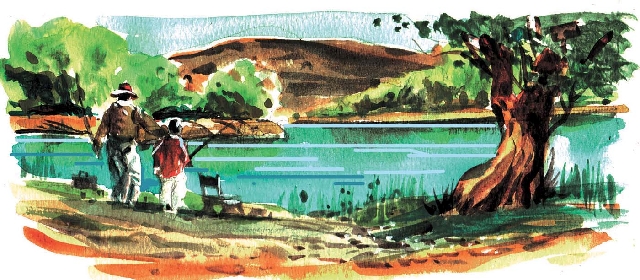Tule Springs remains cool draw for desert dwellers

A historic ranch lies at the heart of Floyd Lamb Park at Tule Springs, a spacious city recreational facility at the edge of northwest Las Vegas.
A good destination for a daytime outing year-round, the park provides respite from city bustle and noise. It is popular for picnics, birding, fishing, exploring on foot, biking, horseback riding and photography.
Known simply as Tule Springs to generations of Las Vegas residents, the park is about 15 minutes north of downtown off U.S. Highway 95. Exit the highway at Durango Drive and turn right. Continue north on Durango to Brent Avenue, where you turn right to reach the park entrance road.
The park is open daily, but the hours of operation change with the seasons. From September to the end of April, it is open from 9 a.m. to 5 p.m. From May through August, it is open from 8 a.m. to 8 p.m. Visitors pay $6 per car, or $1 if entering on foot, by bike or on horseback. Frequent visitors should consider purchasing a $45 annual pass. A senior annual pass is a bargain at $15 for visitors 50 and older. A brochure available at the fee booth details the park’s facilities.
The Sheep Mountains form a beautiful background for the groomed lawns, shade trees, fruit trees and shrubs surrounding the historic core of the ranch marked by the white fences, house, barn and outbuildings. Ducks, geese and peacocks wander the grounds near four ponds that are stocked monthly with fish. Anglers must have Nevada fishing licenses.
A meandering road leads to parking areas for family and group picnic sites. Foot paths explore the verdant ranch area as well as adjacent open desert land. An extended network of desert trails east of the area has scattered shade structures and seating. The desert trails also may be reached from parking areas along Racel Street about a mile south of the park entrance.
The desert is doing its best to produce wildflowers this spring despite spotty winter rainfall. Roadsides near the park are crowded with bright yellow brittlebush and orange mallow. Walkers on the desert pathways will enjoy these exuberant plants as well as many less obvious blooms until the summer heat arrives.
Water bubbling to the surface at Tule Springs in the middle of an arid valley naturally drew animals and early hunter-gatherers to the spot. Native people later tended small plots of beans, corn and other crops at the site. When non-native settlers arrived in the Las Vegas Valley, they utilized the water. Tule Springs became a stop along a stage road to booming Rhyolite a hundred miles north. Bert Nay bought up water rights and land at Tule Springs in 1916 and farmed there until 1928.
The site lay untended for more than a decade until purchased by Prosper Goumond of Las Vegas. Goumond developed an operating livestock ranch and a retreat for family and friends. He took advantage of Nevada’s liberal divorce laws to create a dude ranch where well-heeled people seeking divorces waited out their six weeks — the period of time required to become a Nevada resident for purposes of obtaining a divorce — in a comfortable Western setting with access to the attractions of Las Vegas. Most of the ranch buildings date back to the 1940s.
The property has since changed hands several times, once becoming a state park and twice serving as a city park, which saved it from urban development. It was named for state Sen. Floyd Lamb when it was a state park.
As you drive the approach road and park access road, note the thick layer of light-colored, eroded earth that covers the area. This natural deposit reflects a changing climate over a span of thousands of years. It marks a time when it was much cooler and wetter around Tule Springs. Ice Age animals such as mammoths, camels and early horses watered and fed there, hunted by fierce predators. The eroded layer contains fossils in such rich quantity that this part of the valley is being considered for protection as a new national monument.
Margo Bartlett Pesek’s Trip of the Week column appears on Sundays.